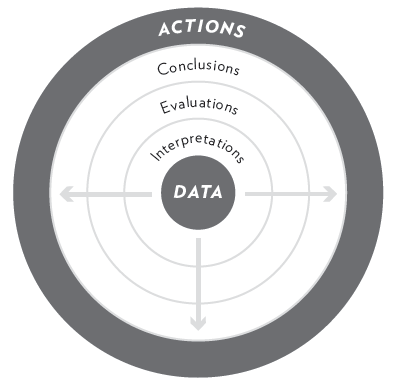The ground rules being used by a cooperative housing community in Connecticut caught our attention recently. We are big proponents of using ground rules to facilitate productive discussions. These ones were especially good because they were thoughtful, detailed, and well-organized. They were also handwritten, which gave them a deeply personal quality (similar to how a handwritten note has so much more impact than an email).

The seven ground rules are:
- Listen attentively and pause before speaking.
Pay attention to others’ words and non-verbal communication. Ask how other people are feeling or what they are thinking rather than making assumptions. If unsure, repeat what you believe the other person is saying. Pause and think about what is being said before speaking. Use eye contact. Avoid side conversations. Turn cells phones off. - Speak directly, honestly and concisely.
Share your ideas. Speak for yourself. Communicate agreement or disagreement explicitly. Don’t assume others know how you feel or what you are thinking. Tell them. If needed, ask for help clarifying what you are trying to say. Speak loudly enough. - Speak your own truth. Be mindful, genuine, and authentic. Synchronize body and mind and remain in the here and now. Say what you feel and what you believe.
- Allow everyone the opportunity to speak. Wait to be recognized by the facilitator. Allow others to speak without interrupting them. Cooperate with the facilitator in giving everyone the opportunity to speak. No one should dominate the conversation. If you’re afraid you want to say, jot it down.
- Assume good intentions. If you don’t understand, ask for clarification. Affirm other people’s expressed feelings. Don’t make attributions about others’ motives.
- Respect each other. Address people with respect. Avid judging, blaming, or patronizing others. Avoid sarcasm and other forms of emotional coercion in place of clearly explaining your disagreement with an idea. Speak to the issue when disagreeing or criticizing instead of focusing on an individual.
- Respect the group. Use the Caring Communication Ground Rules. Hold to time agreements. Respect the facilitator. Avoid being argumentative or engaging in other disruptive behavior. Address private conflict in private, not in the group.
The complete story about this cooperative housing community can be found here: https://www.nytimes.com/2022/02/11/realestate/connecticut-cohousing-foreclosure.html?smid=em-share
Why are ground rules necessary?
If everyone were a master communicator – incapable of distorting the facts, clear about their own motives, able to accept responsibility to see each perspective clearly – then perhaps ground rules would not be necessary.
But no one is a perfect communicator. Even the best communicators fall into traps and pitfalls. Ground rules are the guardrails that guide a strategic conversation safely home. (Click here to learn more about ground rules)
What are some basic ground rules?
The following ground rules have proven successful time after time. Each ground rule points to one of the tools or skills embodied in straight talk.
The Ground Rules
- Understand each other’s styles
- Agree on the meaning of key words
- Tackle issues, not people
- Permit one speaker at a time (avoid side conversations)
- Bring issues to the table (avoid “back room” discussions)
- Keep discussions focused
- Explain the reasoning leading to your conclusions
- Invite inquiry into your views
- Inquire into the reasoning of others
- Make “undiscussable” ideas discussible
- Identify missing data
After proposing this list of ground rules, give people time to digest them, to talk about them, to understand them. Usually this takes about 30 or 45 minutes worth of discussion. The major point to underscore is this:
Ground rules benefit everyone equally.
They are a way to ensure a successful outcome. Therefore, assuming everyone wants a successful outcome, everyone should be motivated to abide by them. At this point, it’s natural that someone asks:
“Why these ground rules? Why not others?”
The answer is: These rules work. You may add to them if you like. But you cannot subtract from them. These rules are the minimum needed for straight talk. Someone will say:
“What happens if someone breaks a rule?”
Don’t be surprised if they do. Human nature being what it is, people will break the rules – even after they agree to abide by them. Usually, it’s not intentional. From kindergarten on:
- We’re trained to advocate our opinions, not challenge them.
- We’re trained to assert a position until another person yields.
- We’re trained to defend ourselves.
Especially at first, people will break the rules all the time. So you need to start slow and give each other constant encouragement. The group will learn from your mistakes. Someone will ask:
“Who should act as policeman?”
The answer: You all will. Each participant should monitor the quality of communication. This requires people to “parallel process.” People will need to track the content of what’s actually being said and, simultaneously, track the quality of the process – i.e. what’s missing, or not being said. It’s like playing a friendly game of softball. Everyone needs to be umpire – even when they’re up to bat.

How does this parallel processing work in practice? When the marketing director starts to talk, you’ve got to be simultaneously listening to her arguments and asking yourself, “Where is she on the Circle of Assumptions? What data is she missing? What’s going on in her Inner Script?” Everyone in the room should be acting in the same capacity – simultaneously acting both as a steward of, and a participant in, the conversation.
“What if we’re scared to speak up?”
The only way to overcome this fear is to practice. People have to see that the rules work. When you point out that a ground rule is being broken, don’t view it as criticizing someone. Instead, view it as helping each other learn a new skill. Keep reminding yourselves: The ground rules benefit everyone. Their purpose is to build understanding, not limit it. None of these rules serve any one person’s interests, only the interests of the group.
What happens if a “bad actor” routinely treads all over the rules?
Often, all that’s necessary is to ask the group whether the ground rules are being adhered to. Calling attention to the behaviors of the group is usually enough to get people to be more sensitive to their behaviors. Another step is for someone to call a quick time-out and invite the person outside to talk about his or her behavior.
Can these ground rules be used in other types of meetings?
Of course. But an hour-long meeting doesn’t afford the time needed to lay out the ground rules thoroughly. Initially, you’ll want to apply them to a meeting of a half-day or more. Afterward, you may choose to apply the ground rules to every meeting.
Conclusion
Over time, you’ll find that people will make the ground rules a matter of honor. They’ll talk about them as being key factors in successful communication. They’ll preach their value to the rest of the organization. And, in time, the culture will evolve to a point where the ground rules are seen as an elementary part of every communication – as principles of conduct rather than rules. At that point, your organization will have become truly a learning organization.
Check out the full article on “The 11 Ground Rules of Straight Talk” to learn more about each rule, and how these rules can lead to communication that is both heated and productive. There is no need to distinguish between a conversation filled with passion and one filled with trust.
Leading with Clarity: Communication Coaching for Executives
 Effective communication is the cornerstone of successful leadership. Our coaching program is designed to help you unlock the power of effective communication and transform your leadership. Through personalized coaching sessions, you’ll learn to speak with impact, lead with clarity, and maximize your leadership potential. Contact us to learn more.
Effective communication is the cornerstone of successful leadership. Our coaching program is designed to help you unlock the power of effective communication and transform your leadership. Through personalized coaching sessions, you’ll learn to speak with impact, lead with clarity, and maximize your leadership potential. Contact us to learn more.
Leading Resources, Inc. is a Sacramento Executive Coaching firm that develops leaders and leading organizations. Subscribe to our leadership development newsletter to download the PDF – “The 6 Trust-Building Habits of Leaders” to learn more about how to build trust with your team.
 Client Member Area
Client Member Area 


